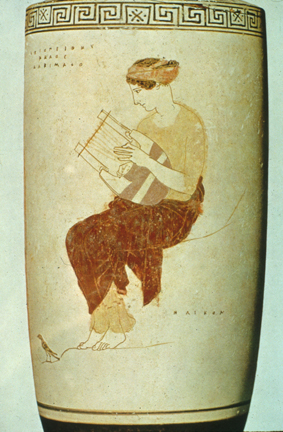
Detail of Greek White Ground Lekythos, Muses on Mt. Helicon
440-430 BCE by the Achilles Painter
ART 198 - HISTORY OF WORLD CERAMICS
| Note the delicacy of the line quality and the subtle way the Achilles Painter uses a thin wash of ocher over the upper torso and around the ankles in this portrayal of a young woman playing her lyre. This transparent wash skillfully indicates a diaphanous fabric worn under her outer tunic, and her arm and ankles are partially revealed beneath it. A Muse was a minor goddess, usually depicted as a young, beautiful and modest virgin. The muses ruled the liberal arts, and were named Clio (muse of history), Euterpe (lyric poetry), Thalia (comedy and idyllic poetry), Melpomene (tragedy), Terpsichore (music and dancing), Erato (erotic poetry), Calliope (epic poetry and rhetoric), Urania (astronomy), and Polymnia (sacred hymns and harmony). Mt. Helicon is a mountain in Southern Greece, and was believed to be the home of the muses, and has come to represent the origin of creative impulses. Here we see Euterpe, delicately strumming her lyre. Her hands and feet are painted with great confidence and skill. A small bird rests at her feet and listens to her plaintive tune. | Detail of Greek White Ground Lekythos, Muses on Mt. Helicon 440-430 BCE by the Achilles Painter |
|
|